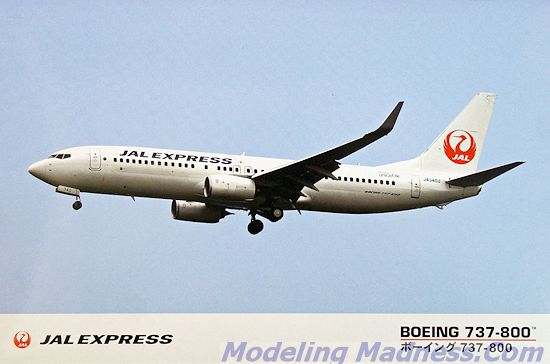
Hasegawa 1/144 B.737-800
| KIT #: | 10690 |
| PRICE: | 3040 yen from Hobby Link Japan |
| DECALS: | One option - multiple registrations |
| REVIEWER: | Scott Van Aken |
| NOTES: | Reboxed Revell kit |

| HISTORY |
The Boeing 737-800 is a short and medium range passenger aircraft. Also called the 737NG, it is a second-generation successor to the 737-300, -400 and -500 series with thoroughly upgraded avionics.
The cockpit is full glass with six CRTs, in the same layout as the Boeing 777. Main wing and tail surfaces have been increased, with special design attention given to a revamping of the main wing structure. The wingtips are now capable of optional fitting with blended winglets -- features designed to improve fuel efficiency and takeoff lift.
The engines are the CFM56 standard for the 737 series, but upgraded for improved fuel efficiency. The 737NG series includes the 120 seat class -600 type, the standard -700, and the stretch body -800 and -900. There are special "ER" extended range variants for the -700 and -900.
When the 737 made its debut, it had a reputation as a strictly short range passenger plane, but with variants like the -700ER, it has evolved into an aircraft capable of ferrying passengers non-stop across the Pacific Ocean. Thanks in large part to its constant improvements and upgrades, the 737 is the best selling short and mid range passenger aircraft in the airline industry.
| THE KIT |
 When
I first requested this kit, I thought it was 1/200. Imagine my surprise when I
got the kit and discovered it was 1/144. Opening the box, I found a white
plastic kit in a bag sealed by tape and a slip in it that said "Made in Poland".
This tells me that it is a reboxing of the Revell AG kit, but with Japanese
livery markings. A look on the HLJ web site shows several similar boxings, each
with a different airline.
When
I first requested this kit, I thought it was 1/200. Imagine my surprise when I
got the kit and discovered it was 1/144. Opening the box, I found a white
plastic kit in a bag sealed by tape and a slip in it that said "Made in Poland".
This tells me that it is a reboxing of the Revell AG kit, but with Japanese
livery markings. A look on the HLJ web site shows several similar boxings, each
with a different airline.
The kit itself is very nicely done and follows the usual Revell airliner moldings, which means it has open holes for the cabin windows and a clear plastic cockpit windscreen piece that also includes a portion of the surrounding airframe. The only clear bits provided are the cockpit piece and some wing leading edge landing light lenses. The kit has no cockpit interior and will require a whopping 20 grams in that space to keep it from tail sitting if one builds it on its gear.
The only pieces to install prior to cementing the fuselage halves together are the nose gear well and a main gear well piece. Hasegawa provides the option to fill in all the cabin windows and use decals. This is how many airliner modelers prefer their kit, but doing so on this one will require the use of a lot of filler and time as there are no clear cabin windows to help fill in the holes. I would use epoxy filler as it does not shrink but will be harder to sand when it is dry.
The wings have separate wing tips and for this boxing, the winglets will be the ones to use. The flap actuators are also separate items. Engines are in several pieces with a 'hot' section that, once glued together, along with the engine fan, are trapped between two cowling/pylon halves. The little winglet on each engine is separate and I'm pleased to see that there is a one-piece forward cowling part as 'split' cowling lips are a bear to fill and smooth.
Though no stand is provided, the kit can be built with the
gear up and there are options for that. If doing gear up, sections of the main
landing gear need to be modified and installed before gluing the wing upper
 and lower
sections together. The landing gear includes separate oleo scissors and
retraction struts for both main and nose gear.
and lower
sections together. The landing gear includes separate oleo scissors and
retraction struts for both main and nose gear.
Instructions are typical of current Hasegawa offerings and have Gunze paint references. There is but one livery option, but a multitude of registration options. Four are provided along with enough numbers to do pretty much any of the fleet. The decals are very well done and include cockpit and cabin windows as mentioned earlier.
| CONCLUSIONS |
This looks to be and should be a very nice kit. I appreciate Hasegawa providing the option to have window decals even though it will take a bit more work to be able to use them. The livery is clean and should be a cinch to get get on the plane with minimal fuss, something I like after struggling with some complex schemes on some recent builds.
| REFERENCES |
Kit instructions
August 2014 Thanks to Hobby Link Japan for the preview kit. You can find
this kit at this link. If you would like your product reviewed fairly and fairly quickly, please
contact
the editor or see other details in the
Note to
Contributors.